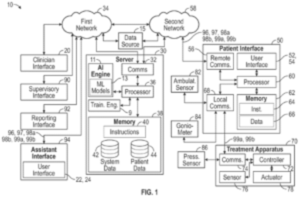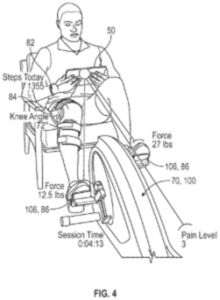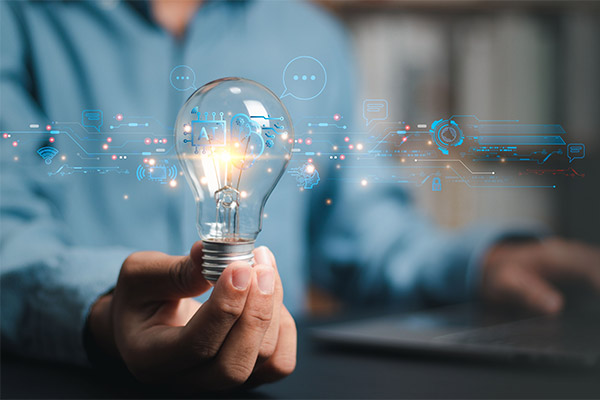Artificial intelligence (AI) encompasses the theory and development of computer systems to perform tasks that normally require human intelligence to accomplish. Machine learning is a subset within AI which utilizes algorithms and statistical models that allow the system to learn and adapt without following explicit directions.
Artificial intelligence is here and will only continue to develop and grow. Inventors in the AI space should understand intellectual property rights associated with AI. Appropriately protecting your AI or machine learning invention using intellectual property is essential to ensure that you are adequately compensated for developing the invention.
Although a patent attorney is not required to prepare and file a patent application, it is highly recommended to use the services of a patent attorney. The average approval rate of a utility patent application by the USPTO from 2011-2020 is 52.8%. This low approval rate highlights the difficulty in receiving a granted patent and the necessity of using a patent attorney.
This article examines how the patent system applies to AI and machine learning inventions to give inventors a better understanding of how to protect their IP rights.
Can You Patent an AI Invention or Machine Learning Model?
Yes, you can patent an AI invention or a machine learning model.
The requirements for patenting an AI invention are the same as other utility patents. Eligibility criteria for a patent includes subject matter, novelty, nonobvious, and usefulness.
An invention for AI or machine learning incorporates software and the patent will be akin to other software patents.
Subject Matter Eligibility
To be eligible for a utility patent the invention must be either a process, machine, manufacture, or composition of matter.
Although executing software code in and of itself can be considered a process, courts have closely scrutinized how the subject matter eligibility criteria applies to software.
Even if an invention falls under a subject matter eligible category it may not be subject matter eligible if it is considered a judicial exception. Judicial exceptions include abstract ideas, laws of nature, and natural phenomena.
The Supreme Court of the United States reasoned that because abstract ideas, laws of nature, and natural phenomenon “are the basic tools of scientific and technological work”, monopolizing these tools by granting patent rights may impede innovation rather than promote it.
The claims of the patent must not be directed to a judicial exception unless “the claim as a whole includes additional limitations amounting to significantly more than the exception.”
Applying this rationale to software patents, courts have held that simply implementing a mathematical principle on a computer is not a patentable application of that principle.
For an AI or machine learning invention to overcome this judicial exception it must have a real-world application.
Novelty
The invention must be novel, meaning new and never having been done before. Get familiar with the term “prior art” before you begin the application process.
Prior art is any published literature describing any part of your claimed invention. Patent examiners spend a lot of their time searching through databases to find prior art. You may not obtain a patent on anything that exists in the prior art. Prior art includes patents, patent applications, non-patent literature, and anything else that is publicly available.
Nonobvious
The invention must not be obvious. Obvious to whom? The United States Patent and Trademark Office (USPTO) uses a standard called a Person Having Ordinary Skill In The Art (PHOSITA).
If a PHOSITA would find the invention obvious, then it is not eligible for a patent. What a PHOSITA would find obvious varies with the art category and is subject to some debate.
A PHOSITA in the art of AI and machine learning would likely be a computer scientist or engineer.
Useful
The invention must be useful. This is an extremely low bar to meet, nearly anything can be considered useful.
How Do You Patent an AI or Machine Learning Invention?
Filing a patent is a multi-step process and an applicant may choose to abandon pursuing a patent at any step. Skipping steps or proceeding out of order may ultimately cause irreparable harm. If you file a patent without conducting the necessary research, you may be attempting to patent something that already exists.
This following guide shows a general roadmap for filing a patent, but each invention is unique, and the process may vary slightly.
A registered patent attorney is the best person to provide you advice on how to patent an AI or machine learning invention. While you can always contact a patent lawyer at any point, it is best to work with an attorney from the outset.
1. Turn Your Idea into an Invention
The basic starting place for a patent is the conception of an idea to solve a problem. Before the idea can be patented it must be developed into an invention. An idea becomes an invention when it is fundamentally tied to something in the real world and has a real-world application.
Expand the idea into something that can be implemented into the real world. Think through all aspects of how the idea could be part of real life.
2. Perform Market Research
A patent provides an economic incentive for people to invent new things. There isn’t much point in applying for a patent if you can’t make money off it. Performing market research helps the inventor make an informed decision whether paying the cost of a patent application is worth it.
Before beginning the patenting process, make sure you understand the market potential of your invention and have a plan for how to make money from a patent. In certain instances, you may be better off not filing for a patent but rather protecting your invention as a trade secret.
3. Conduct a Patentability Search
The USPTO requires an invention to be novel so a patent cannot claim anything that already exists. Before beginning the application process, an inventor must explore what has already been done to make sure they can patent their invention.
A patentability search, also known as a prior art search, attempts to discover as many relevant sources as possible that might be used by the USPTO to prevent a patent being granted. An inventor should always do their own preliminary research to understand the technological field. A good place for an inventor to start conducting their own research is Google patents, Google scholar, and the USPTO patent database. Try using different combinations of Boolean and keyword searches. Google patents has a function that shows related patents at the bottom of the page. Explore as much as you can. The USPTO has a step-by-step tutorial of how to conduct a preliminary patent search.
Although inventors should conduct their own research, it is recommended to use a professional researcher. A patentability search can be conducted by a patent attorney, or a patent research company. Professional research services generally have subscriptions to databases, giving them access to more sources than an independent inventor would have.
If an inventor is not trained in performing research, they may miss important prior art references. Using a professional researcher provides the highest level of confidence that your invention is unique, and worth taking to the next step in the patent process. A professional research company may charge anywhere from $100-$1,000+ for a patentability search depending on the subject matter.
4. Verify Patent Eligibility
Remember, to be eligible for a patent and invention must be the right subject matter, must be novel, nonobvious, and useful. A patent attorney is the best person to provide a patentability opinion on whether your invention meets the eligibility criteria.
The patent attorney will review the prior art from the patentability search and advise if they think your invention is in fact novel and nonobvious in view of what has already been done.
5. Determine Inventorship & Ownership
An inventor is entitled to ownership of a patent for their invention. Who the inventor is might not always be clear.
A person is considered an inventor if they contributed to the conception of the invention. If multiple people contribute to the conception, they are all considered inventors. If a person is a named inventor on a patent, they have rights to the entirety of the patent.
If there are two or more inventors, each can separately, and without permission of the other, use and license the use of the patent. This can be an issue because co-inventors can become direct competitors of each other. To prevent this issue from arising, co-inventors may sign a contract before filing the patent application. They may agree to not compete, or they may form a company that they all own and assign the patent rights to the company.
Most companies include intellectual property clauses in their employment contracts assigning all employees ideas and inventions to the company if made “in the scope of employment.” If you invent something during your job, for your job, and file a patent for it, you may be considered the inventor, but the company owns the rights to the patent.
If you are employed, it is very important to read and understand your employment contract. Consulting a patent attorney is highly recommended to interpret the meaning of intellectual property clauses in employment contracts.
Before proceeding with a patent application determine who conceived what aspects of the invention. This information should be logged in your patent journal. Discuss with all inventors how credit for the invention should be allocated.
6. Prepare the Patent Application
Most inventors use the services of a registered patent attorney to prepare and file the patent application. Although an inventor may file and obtain their own patent, there is no guarantee that the patent would sufficiently protect the invention. Each patent application has several forms that must be filled out and submitted. The patent specification can be drafted from scratch or by using templates.
If you are an individual inventor, you should also fill out the certification of micro entity status form to reduce the amount of fees due. All applications must be submitted to the USPTO in English.
7. Submit the Patent Application
The patent application documents can be submitted for examination on the Patent Center website. It is recommended that an inventor uses the services of a patent attorney to submit the patent application.
8. Prosecute the Patent Application
It takes some time for the USPTO to start examining an application due to the large number of applications received. The time it takes for the USPTO to begin examining a patent varies by the invention’s technological field. The historical time to receive a first office action is 17.6 months. Very few applications are approved on the first office action.
The applicant then fixes the issues the USPTO indicates in the first office action and resubmits for a second examination. If the applicant correctly fixes all the issues, then a notice of allowance is issued. The typical amount of time for a patent application to make it to an allowance or final rejection is 23.4 months.
9. Receive an Issued Patent
A patent application will issue as a granted patent after the USPTO approves the application and the issue fee is paid. Congratulations!
10. Use and maintain the patent.
You have a patent, now what? This is where the market research comes in handy. You likely have spent a lot of time and money inventing and patenting your invention. Now it’s time to reap the fruits of your labor.
The owner of a patent may choose to make their invention and use the patent to prevent competitors from doing the same. The owner may choose to license the use of the patent out to another and keep the rights to the patent. Or the owner may choose to outright sell all the rights they have in the patent to another.
Don’t forget that a utility patent requires maintenance fee payments to keep the patent valid. These fees are due at 3.5 years, 7.5 years, and 11.5 years.
AI and Machine Learning Patent Examples
Consider the following examples to better understand they types of AI and machine learning patents that exist.
Here is a patent that was granted in 2022 for an invention that uses AI and machine learning. This AI invention is for a Method and system for using artificial intelligence and machine learning to provide recommendations to a healthcare provider in or near real-time during a telemedicine session.


Figure 1 is a block diagram illustrating the overarching process of implementing the AI and machine learning algorithm. This process on its own might not be considered subject matter eligible as an abstract idea. Tying the process to the machine in a telemedicine session gives the process a clear and concrete real-world application.
Here are some other examples of AI and machine learning patents. Follow the links to view the patent.
- Unified nonlinear modeling approach for machine learning and artificial intelligence (attractor assisted AI)
- Determining context and intent in omnichannel communications using machine learning based artificial intelligence (AI) techniques
- Artificial intelligence system for supporting communication
- Systems and methods for intelligently curating machine learning training data and improving machine learning model performance
- Compression in machine learning and deep learning processing
- Methods and apparatus for machine learning predictions of manufacturing processes
While developing your AI and machine learning invention be sure to consider the real-world application of your invention. To receive a granted patent you need to be able to describe the application of the AI or machine learning.
FAQs About AI Patents
The cost of a utility patent granted by the USPTO for an AI invention can range anywhere from less than $1,000 to over $20,000. The cost of a utility patent varies based on the complexity of the invention, professional services used, and the status of the inventor.
| Type of Fee | Cost |
|---|---|
| Preliminary patent search | $500-$1,000+ |
| USPTO fees | $755-$3,020+ |
| Drawing fees | $50-$500+ |
| Patent Attorney fees | $3,000-$15,000+ |
| Total Cost | $4,000-$20,000+ |
A utility patent for an AI invention can last up to 20 years after the date of application. Maintenance fees must be paid 3.5, 7.5, and 11.5 years after the issue date or the patent rights will expire.
No, an inventor does not need an attorney to file a patent application with the USPTO. However, it is highly recommended to use the services of a patent attorney for an AI product. Patent attorneys or agents are the only people who have legal authority to assist an inventor with prosecuting a patent.
Drafting a patent application which adequately protects the invention is a difficult task. Although using a patent attorney cannot guarantee the inventor a patent, it will increase the likelihood of receiving a granted patent with strong claims.
Sheldon Brown
Sheldon received his training of the patent system at the United States Patent & Trademark Office. He works with universities and consultants to provide analytics and guidance for technology commercialization from patents.

Patent Process Menu
Talk with a Patent Attorney
Get a free consultation from a patent attorney and protect your invention.
